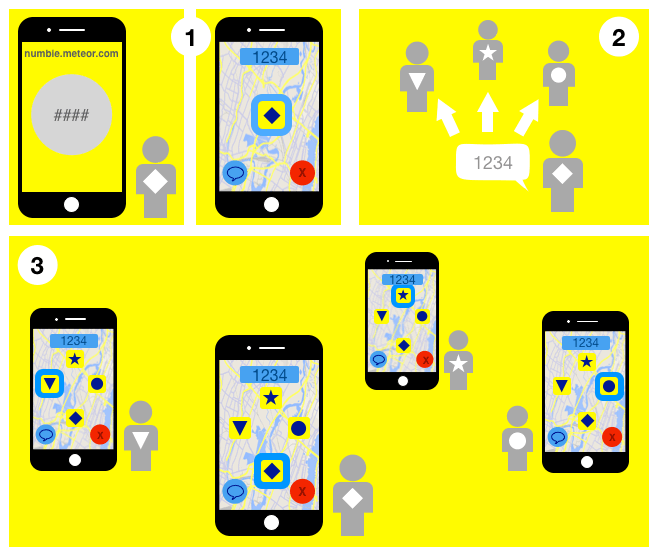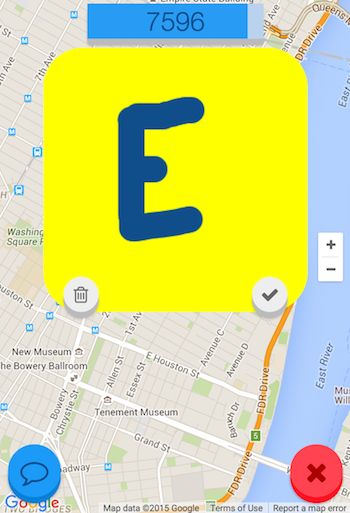
Numbie
Throughout this year, I have been developing a small online service called numbie. Numbie provides an easy way to share your location with a group of people. The twist is that you do not need to befriend or follow the people you want to share your location with or have them added to any of your social networks. And, even if you do know the people to share your location with, you do not need to have to be users of the same social services. Rather, a numbie is an ephemeral, anonymous identifier that can easily be shared to enable users to see their respective positions in realtime, from any device, without registration.
How numbie works
Numbie is a webapp, currently available for testing at https://numbie.herokuapp.com/. Numbie is optimized to be used by mobile devices, as we expect users to primarily share their location on the go. A basic usage works like this:
- On https://numbie.herokuapp.com/, a user clicks once to create a numbie, represented by a 4 digit number. The user immediately starts sharing her or his position on a map.
- The user communicates the numbie to the persons to share her or his location with using any messaging or social service or even by making a phone call. Because the numbie is only 4 digits, communicating it verbally is easy.
- The other users enter the numbie at https://numbie.herokuapp.com/ or go directly to https://numbie.herokuapp.com/<numbie>. They immediately start to share their location. Every active user can now see each others location on a map in real time.
 Image 1: How numbie works
Image 1: How numbie works
One of the principles of numbie is that numbies are ephemeral. This helps protecting privacy as entering a numbie requires no signup or login. A numbie exists only for a limited amount of time, typically for 5 minutes. Once it ceases to exist, all active users automatically stop sharing their location. Through a progress bar, users get feedback on how long the numbie remains active. The creator of the numbie has the option to reset a numbie's lifespan or even to expand it up to 1 hour. The owner can also decide to destroy a numbie at any time before it expires.
 Image 2: Users can create hieroglyphs to identify themselves
Image 2: Users can create hieroglyphs to identify themselves
To be able to identify one another when using numbie, users can customize their realtime marker on the map using a hieroglyph. To do so, the user click on her or his marker and then draws her or his custom hieroglyph, for example an initial or iconic symbol. Hieroglyphs aim to strike a balance between beeing able to identify yourself while not giving up a lot of privacy.
How numbie was created
The idea for numbie originated from my friend Hani Jamjoom and the development was also supported by my friend Jim Laredo. We created an initial version at the TechCrunch Disrupt NY Hackathon in May 2015. This video shows our 1 minute pitch of the first, hacked together version. Since then, we re-implemented the service from the ground up. Under the hood, it uses Meteor.js for real-time communication between clients and a central server and the Google maps API for displaying a user's location.
Over time, we identified a few design goals for numbie. For example, numbie tries to avoid text as much as possible. We want numbie to be usabe worldwide and no matter what your language is. This is especially important as we envision numbie to be used in countries where addresses are flacky or non-existent and where we cannot assume users to know English. Thus, numbie mostly relies on numbers and symbols in its user interface. Also, we want to enable unintrusive access to numbie. To make using numbie as easy as possible, the service does not require any signup or dedicated app. That way, numbie works across mobile devices or even on desktops. Finally, numbie does not persist any information. The service actually operates completely without using any database or disk. Everything is in memory.
The state of affairs
For now, we are happy numbie exists as a usable prototype. We use it ourselves quite a bit to meet each other and friends in and around New York. Quickly, a convention arose: if someone texts you a four digit number, you know its a numbie. There are multiple ways the service could be extended, allowing for example to indicate a meeting point in real-time or to have private, protected numbies. There are also some challenges ahead, for example, how to deal with the natural limitation of at most 10000 concurrent numbies at a time.
We would love to hear what you think of the service. Feel free to try it out at https://numbie.herokuapp.com/. And please leave your comments below.